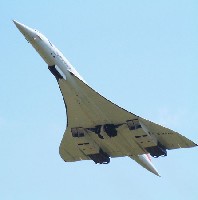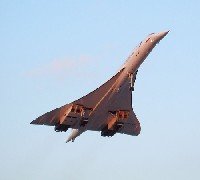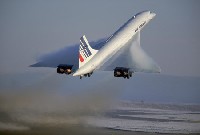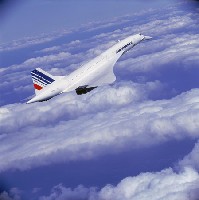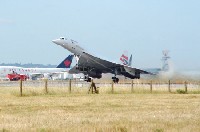Global Aircraft -- Concorde
|
Aviation Center
US Attack
US Bombers
US Cargo
US Fighters
US Helicopters
US Patrol/Pursuit
US Reconnaissance
US Tankers
US Trainers
US UAV's
US X Planes
Orbiter Vehicles
WWI Aircraft
WWII Aircraft
Airbus
Antonov
Boeing
Dassault
Ilyushin
Kamov
MiG
Mil
Saab
Sukhoi
Tupolev
Yakovlev
Joint/Rest of World
Entertainment Center
Members Center
New Technologies
Contact Us
Extra Navigation
GAC Engine
Concorde Specifications
Concorde Achievements
Concorde Features
Concorde was an ogival delta-winged ("OG delta wing") aircraft with four Olympus engines based on those originally developed for the Avro Vulcan strategic bomber. The engines were jointly built by Rolls-Royce and SNECMA. Concorde was the first civil airliner to have an analogue fly-by-wire flight control system. It also employed a trademark droop snoot lowering nose section for visibility on approach.
These and other features permitted Concorde to have an average cruise speed of Mach 2.02 (about 2,140 km/h or 1,330 mph) with a maximum cruise altitude of 18,300 metres (60,000 feet), more than twice the speed of conventional aircraft. The average landing speed was a relatively high 298 km/h (185 mph, 160 knots). Concorde pioneered a number of technologies: For high speed and optimisation of flight: Double-delta (ogee/ogival) shaped wings Variable inlet ramps Supercruise capability Thrust-by-wire engines, predecessor of today's FADEC-controlled engines Droop-nose section for improved visibility in landing For weight-saving and enhanced performance: Mach 2.04 (~2,200 km/h - 1350 mph) cruising speed for optimum fuel consumption (supersonic drag minimum, although turbojet engines are more efficient at high speed) Mainly aluminium construction for low weight and relatively conventional manufacture (higher speeds would have ruled out aluminium) Full-regime autopilot and autothrottle allowing "hands off" control of the aircraft from climbout to landing Fully electrically controlled analogue fly-by-wire flight controls systems Multifunction flight control surfaces High-pressure hydraulic system of 28 MPa (4,000 lbf) for lighter hydraulic systems components Fully electrically controlled analogue brake-by-wire system Pitch trim by shifting fuel around the fuselage for centre-of-gravity control Parts made using 'sculpture milling' from single alloy billet reducing the part-number count, while saving weight and adding strength Lack of Auxiliary power unit (Relying on the fact that Concorde will be used for premium services to big airports, where a ground air start cart would be readily available) Flush fitting lights The Concorde programme's primary legacy is in the experience gained in design and manufacture which later became the basis of the Airbus consortium.[citation needed] Snecma Moteurs' involvement with the Concorde programme prepared the company's entrance into civil engine design and manufacturing, opening the way for Snecma to establish CFM International with General Electric and produce the successful CFM International CFM56 series engines. Although Concorde was a technological marvel when introduced into service in the 1970s, 30 years later its cockpit, cluttered with analogue dials and switches, looked dated. With no competition, there was no commercial pressure to upgrade Concorde with enhanced avionics or passenger comfort, as occurred in other airliners of the same vintage, for example the Boeing 747. The key partners, BAC (later to become BAE Systems) and Aerospatiale (later to become EADS), were the joint owners of Concorde's type certificate. Responsibility for the Type Certificate transferred to Airbus with formation of Airbus SAS.
Concorde Background
In the late 1950s, the United Kingdom, France, United States and Soviet Union were considering developing supersonic transport. Britain's Bristol Aeroplane Company and France's Sud Aviation were both working on designs, called the Type 233 and Super-Caravelle, respectively. Both were largely funded by their respective governments. The British design was for a thin-winged delta shape (which owed much to work by Dietrich Kuchemann) for a transatlantic-ranged aircraft for about 100 people, while the French were intending to build a medium-range aircraft.
The designs were both ready to start prototype construction in the early 1960s, but the cost was so great that the British government made it a requirement that BAC look for international co-operation. Approaches were made to a number of countries, but only France showed real interest. The development project was negotiated as an international treaty between the two countries rather than a commercial agreement between companies and included a clause, originally asked for by Britain, imposing heavy penalties for cancellation. A draft treaty was signed on 28 November 1962. By this time, both companies had been merged into new ones; thus, the Concorde project was between the British Aircraft Corp. and Aerospatiale. Scheduled flights began on 21 January 1976 on the London-Bahrain and Paris-Rio (via Dakar) routes. The U.S. Congress had just banned Concorde landings in the US, mainly due to citizen protest over sonic booms, preventing launch on the coveted transatlantic routes. However, the U.S. Secretary of Transportation, William Coleman, gave special permission for Concorde service to Washington Dulles International Airport, and Air France and British Airways simultaneously began service to Dulles on 24 May 1976. When the U.S. ban on JFK Concorde operations was lifted in February 1977, New York banned Concorde locally. The ban came to an end on 17 October 1977 when the Supreme Court of the United States declined to overturn a lower court's ruling rejecting the Port Authority's efforts to continue the ban (The noise report noted that Air Force One, at the time a Boeing VC-137, was louder than Concorde at subsonic speeds and during takeoff and landing.). Scheduled service from Paris and London to New York's John F. Kennedy Airport began on 22 November 1977.[citation needed] Flights operated by BA were generally numbered "BA001" (London to New York), "BA002" (New York to London), "BA003" (London to New York) and "BA004" (New York to London). Air France flight numbers were generally "AF001" (New York to Paris) and "AF002" (Paris to New York). By around 1981 in the UK, the future for Concorde looked bleak. The government had lost money operating Concorde every year, and moves were afoot to cancel the service entirely. A cost projection came back with greatly reduced metallurgical testing costs, but still, having lost money for so many years, the government was not keen to continue. In late 1983, the managing director of BA, Sir John King, managed to get the government to sell the aircraft outright to (the then state owned, later privatised) BA for 16.5 million plus the first year's profits. After doing a market survey and discovering that their target customers thought that Concorde was more expensive than it actually was, BA progressively raised prices to match these perceptions. It is reported that BA then ran Concorde at a profit, unlike their French counterparts. The plane was reckoned to make an operating profit for British Airways after the British and French governments agreed to write off the development costs of the plane. BA's profits have been reported to be up to 50 million in the most profitable year, with a total revenue of 1.75 billion, before costs of 1 billion. While commercial jets take seven hours to fly from New York to Paris, the average supersonic flight time on the transatlantic routes was just under 3.5 hours. In transatlantic flight, Concorde travelled more than twice as fast as other aircraft - other aircraft frequently appeared to be flying backwards. Up to 2003, Air France and British Airways continued to operate the New York services daily. Concorde also flew to Barbados's Grantley Adams International Airport during the winter holiday season. Until the AF Paris crash ended virtually all charter services by both AF and BA, several UK and French tour operators operated numerous charter flights to various European destinations on a regular basis. The Paris Crash On 25 July 2000, Air France Flight 4590, registration F-BTSC, crashed in Gonesse, France, killing all 100 passengers and nine crew on board the flight, and four people on the ground. It was the only fatal incident involving the type. According to the official investigation conducted by the French accident investigation bureau (BEA), the crash was caused by a titanium strip, part of a thrust reverser, that fell from a Continental Airlines DC-10 that had taken off about four minutes earlier. This metal fragment punctured a tyre on the left main wheel bogie. The tyre exploded, and a piece of rubber hit the fuel tank and broke an electrical cable. The impact caused a hydrodynamic shockwave that fractured the fuel tank some distance from the point of impact. This caused a major fuel leak from the tank, which then ignited due to severed electrical wires which were sparking. The crew shut down engine number 2 in response to a fire warning but were unable to retract the landing gear, hampering the aircraft's climb. With engine number 1 surging and producing little power, the aircraft was unable to gain height or speed, entering a rapid pitch-up then a violent descent, rolling left. The impact occurred with the stricken aircraft tail-low, crashing into the Hotelissimo Hotel in Gonesse. Prior to the accident, Concorde had been arguably the safest operational passenger airliner in the world in terms of passenger deaths-per-kilometres travelled with zero. After the accident, the death rate was 12.5 fatal events per million flights, more than three times that of the second worst aircraft. However no aircraft's safety can be accurately measured from a single incident and safety improvements were made in the wake of the crash. The crash of the Air France Concorde nonetheless proved to be the beginning of the end for the type. On 10 April 2003, Air France and British Airways simultaneously announced that they would retire Concorde later that year. They cited low passenger numbers following the 25 July 2000 crash, the slump in air travel following 9/11 and rising maintenance costs. It has been suggested that Concorde was not withdrawn for the reasons usually given, but that during the grounding of Concorde it became apparent to the airlines that they could actually make more revenue carrying their first class passengers subsonically. In 2000 Concorde was most useful in the celebrations of the millenium. This allowed england and france to fly to america quickly enough to celebrate the millenium with americans aswell. It would have taken 7 hours in a normal jet but concorde only took 2 hours. Some reports say they landed with only 78GALLONS of fuel left in the tanks (they afterburned on several occasions to get there quicker) | ||||||||||||||||||||||||||||||||||||||||||||||

